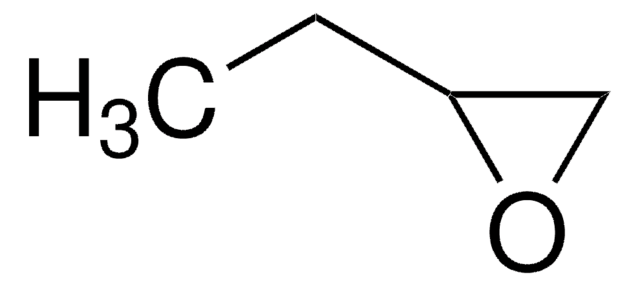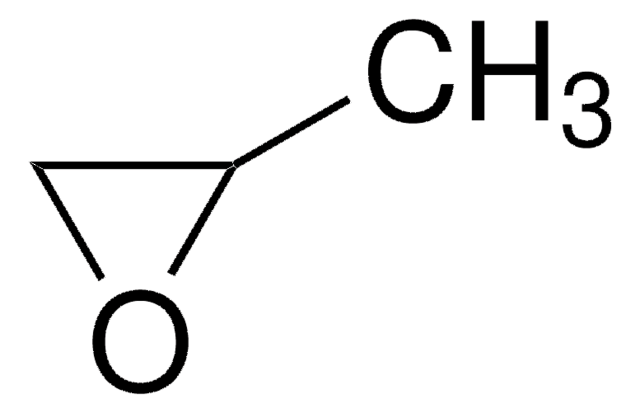추천 제품
Quality Level
분석
97%
양식
liquid
불순물
<3% acetic acid
refractive index
n20/D 1.406 (lit.)
bp
118-120 °C (lit.)
density
0.831 g/mL at 25 °C (lit.)
저장 온도
2-8°C
SMILES string
CCCCC1CO1
InChI
1S/C6H12O/c1-2-3-4-6-5-7-6/h6H,2-5H2,1H3
InChI key
WHNBDXQTMPYBAT-UHFFFAOYSA-N
유사한 제품을 찾으십니까? 방문 제품 비교 안내
애플리케이션
- Poly (epichlorohydrin-co-1, 2-epoxyhexane)–a promising precursor for an energetic azido polymer for cast-cure: Discusses the synthesis of a copolymer using epichlorohydrin and 1,2-epoxyhexane, aiming to develop an internal plasticizer for energetic applications (TM Klapötke, 2016).
- Synthesis of hierarchically porous zeolite TS-1 with small crystal size and its performance of 1-hexene epoxidation reaction: This study investigates the catalytic performance of 1,2-epoxyhexane in the preparation of intermediates for various chemical industries (M Zhang et al., 2021).
- Bioproduction of Chiral Epoxyalkanes using Styrene Monooxygenase from Rhodococcus sp. ST‐10 (RhSMO): Focuses on the enzymatic production of (S)-1,2-epoxyhexane using a biocatalyst, highlighting its potential in creating chiral epoxyalkanes (H Toda et al., 2014).
- Silica islands regulated external Ti‐site environment of TS‐1 for enhanced performance of 1‐hexene epoxidation: Explores the use of modified TS-1 catalysts to improve the selectivity and performance of 1,2-epoxyhexane in epoxidation reactions (J Yuan et al., 2023).
- Gas-phase Photocatalytic Oxidation of 1-Hexene Using Heterogeneous Semiconductor Materials: Describes the synthesis of 1,2-epoxyhexane through gas-phase photocatalytic oxidation, focusing on the selectivity and efficiency of the process (EA Kamba et al., 2023).
신호어
Danger
유해 및 위험 성명서
Hazard Classifications
Acute Tox. 4 Oral - Eye Irrit. 2 - Flam. Liq. 2 - Skin Irrit. 2 - STOT SE 3
표적 기관
Respiratory system
Storage Class Code
3 - Flammable liquids
WGK
WGK 3
Flash Point (°F)
59.0 °F - closed cup
Flash Point (°C)
15 °C - closed cup
개인 보호 장비
Eyeshields, Faceshields, Gloves, type ABEK (EN14387) respirator filter
W J Choi et al.
Applied microbiology and biotechnology, 54(5), 641-646 (2000-12-29)
A two-phase membrane bioreactor was developed to continuously produce enantiopure epoxides using the epoxide hydrolase activity of Rhodotorula glutinis. An aqueous/organic cascade, hydrophilic, hollow-fiber membrane bioreactor was used: (1) to carry out large-scale resolution of epoxides, (2) to continuously extract
Christopher J Backlund et al.
Acta biomaterialia, 29, 198-205 (2015-10-20)
The effect of nitric oxide (NO)-releasing dendrimer hydrophobicity on Streptococcus mutans killing and biofilm disruption was examined at pH 7.4 and 6.4, the latter relevant to dental caries. Generation 1 (G1) poly(amidoamine) (PAMAM) dendrimers were modified with alkyl epoxides to
Zhimin Xue et al.
Chemistry, an Asian journal, 12(17), 2271-2277 (2017-06-20)
Development of inexpensive, easily prepared, non-toxic, and efficient catalysts for the cycloaddition of CO
Ranjai Kumar et al.
Protein expression and purification, 79(1), 49-59 (2011-04-26)
A putative epoxide hydrolase-encoding gene was identified from the genome sequence of Cupriavidus metallidurans CH34. The gene was cloned and overexpressed in Escherichia coli with His(6)-tag at its N-terminus. The epoxide hydrolase (CMEH) was purified to near homogeneity and was
Kelli L Hvorecny et al.
Structure (London, England : 1993), 25(5), 697-707 (2017-04-11)
Pseudomonas aeruginosa secretes an epoxide hydrolase with catalytic activity that triggers degradation of the cystic fibrosis transmembrane conductance regulator (CFTR) and perturbs other host defense networks. Targets of this CFTR inhibitory factor (Cif) are largely unknown, but include an epoxy-fatty
자사의 과학자팀은 생명 과학, 재료 과학, 화학 합성, 크로마토그래피, 분석 및 기타 많은 영역을 포함한 모든 과학 분야에 경험이 있습니다..
고객지원팀으로 연락바랍니다.








